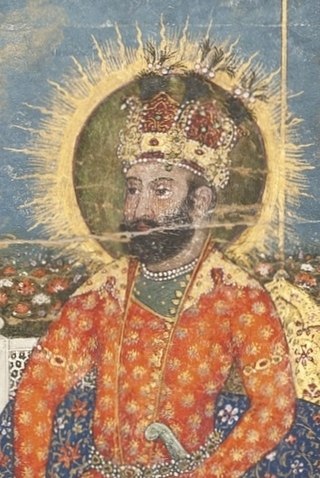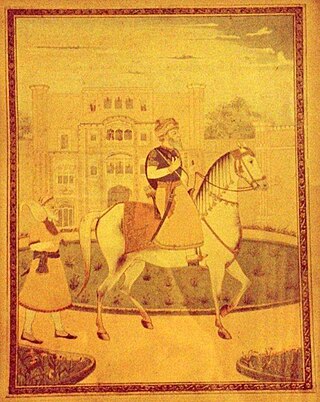
The Durrani Empire or the Afghan Empire, also known as the Sadozai Kingdom, was an Afghan empire that was founded by Durrani tribe of Pashtuns, under the Ahmad Shah Durrani in 1747, that spanned parts of Central Asia, the Iranian plateau, and the Indian subcontinent. At its peak, it ruled over the present-day Afghanistan, much of Pakistan, parts of northeastern and southeastern Iran, eastern Turkmenistan, and northwestern India. Next to the Ottoman Empire, the Durrani Empire is considered to be among the most significant Islamic empires of the second half of the 18th century.

Zaman Shah Durrani, or Zaman Shah Abdali, was the third King of the Durrani Empire from 1793 until 1801. An ethnic Pashtun of the Sadozai clan, Zaman Shah was the grandson of Ahmad Shah Durrani and the fifth son of Timur Shah Durrani.

The Sukerchakia Misl was one of twelve Sikh misls in Punjab during the 18th century, concentrated in Gujranwala and Hafizabad districts in western Punjab and ruled from (1752–1801). The misl was founded by Charat Singh of Sandhawalia, grandfather of Maharaja Ranjit Singh. The last Sukerchakia Misldar was Maharaja Ranjit Singh. Towards the end of the eighteenth century, Maharaja Ranjit Singh united all the misls and established an independent Sikh Empire.

Shah Alam II, also known by his birth name Ali Gohar, or Ali Gauhar, was the seventeenth Mughal emperor and the son of Alamgir II. Shah Alam II became the emperor of a crumbling Mughal Empire. His power was so depleted during his reign that it led to a saying in the Persian language, Sultanat-e-Shah Alam, Az Dilli ta Palam, meaning, 'The empire of Shah Alam is from Delhi to Palam', Palam being a suburb of Delhi.

The Durrani dynasty was founded in 1747 by Ahmad Shah Durrani at Kandahar, Afghanistan. He united the different Pashtun tribes and created the Durrani Empire. which at its peak included the modern-day Afghanistan, Pakistan, as well as some parts of northeastern Iran, eastern Turkmenistan, and northwestern India including the Kashmir Valley.

Jassa Singh Ahluwalia was a Sikh leader during the period of the Sikh Confederacy, being the supreme leader of the Dal Khalsa. He was also Misldar of the Ahluwalia Misl. This period was an interlude, lasting roughly from the time of the death of Banda Bahadur in 1716 to the founding of the Sikh Empire in 1801. He founded the Kapurthala State in 1772.

The Afghan–Sikh wars spanned from 1748 to 1837 in the Indian subcontinent, and saw multiple phases of fighting between the Durrani Empire and the Sikh Empire, mainly in and around Punjab region. The conflict's origins stemmed from the days of the Dal Khalsa, and continued after the Emirate of Kabul succeeded the Durrani Empire.
Zain-ud-Din Khan known as Zain Khan Sirhindi was the Mughal Faujdar of Sirhind, he was a serviceman of Shah Alam II, an ally of Najib-ud-Daula and Ahmad Shah Durrani. Zain Khan Sirhindi fought during the Third Battle of Panipat and strengthened Mughal rule in the region.

The Afghan-Maratha War was fought between the Afghan Empire under Ahmad Shah Durrani and the Maratha Empire and the Sikh Confederacy between 1758 and 1761. It took place in north-west India, primarily the region around Delhi and Punjab.

Timur Shah Durrani, also known as Timur Shah Abdali or Taimur Shah Abdali was the second ruler of the Afghan Durrani Empire, from November 1772 until his death in 1793. An ethnic Pashtun, he was the second eldest son of Ahmad Shah Durrani.
The Battle of Kup was fought on 5 February 1762, between the Afghan forces of Ahmad Shah Durrani and the Sikhs, under the command of Jassa Singh Ahluwalia and Charat Singh. Ahmad Shah Durrani and the Afghan forces reached Malerkotla, west of Sirhind. They were met by between 30,000 and 50,000 Sikhs. Abdali's forces outnumbered the Sikhs in hand-to-hand combat and the Sikhs couldn't use their usual tactics of hit and run, but had to engage in battle while protecting the civilians at the same time. The Sikhs created a human ring around civilians as protection and fought the battle as they advanced towards Barnala. Abdali was able to break the ring and carried out a full scale massacre of the Sikh civilians. Ahmad Shah's forces killed several thousand Sikhs, and the surviving Sikhs fled to Barnala. According to various different estimates, as many as 5,000 to 30,000 Sikh men, women, elderly and children were killed in what is known as the second Sikh genocide.
The Battle of Gujranwala was fought between the Durrani Empire and the Sikh Confederacy in September 1761.

Ahmad Shah Durrani, the founder of the Durrani Empire, invaded Indian subcontinent for eight times between 1748 and 1767, following the collapse of Mughal Empire in the mid-18th century. His objectives were met through the raids and deepened the political crisis in India.
The Battle of Sialkot was fought between Durrani Empire and Sukerchakia Misl of Dal Khalsa in 1761.

The Battle of Amritsar, also known as the Battle of Gohalwar, was fought between the Durrani Empire and Shaheedan Misl of the Dal Khalsa on 11 November 1757. Following the fourth invasion of Ahmad Shah Durrani, his army was attacked by Sikh bands under the command of Ala Singh and Baba Deep Singh. Following the attacks, Ahmad Shah desecrated the Sikh holy site known as the Shri Harmandir Sahib in Amritsar. The news of the desecration reached Baba Deep Singh who vowed to liberate the holy site from the Afghans. This resulted in a pitched battle being fought in the village of Gohalwar, near Amritsar. The battle resulted in Baba Deep Singh being killed and an Afghan victory.
The Battle of Mahilpur was fought between the Sikh Misls and Adina Beg Khan against the Durrani Empire in December 1757. Following the 4th invasion of Ahmad Shah Durrani, he appointed Timur Shah as the viceroy of Punjab with Jahan Khan as his deputy. The Afghans appointed Adina Beg Khan as the faujdar of the Jalandhar Doaba and exempted him from attending court at lahore, on the condition that Adina Beg pay revenue to the Afghan government. Soon a dispute regarding the payment of revenue occurred between Adina Beg and the Afghans. This dispute soon escalated which resulted in Jahan Khan sending an Afghan force to arrest Adina Beg. Adina Beg formed a military alliance with the Sikhs under the command of Jassa Singh Ahluwalia and Vadbhag Singh Sodhi. Adina Beg also gained the support of Sadiq Beg Khan, Khwaja Mirza Khan, and Raja Bhup Singh. Adina Beg along with the Sikh forces fought the Afghans at Mahilpur. The battle resulted in a victory for Adina Beg and the Sikhs and resulted in the entire Jalandhar Doaba being occupied and sacked by the Sikh forces.

The siege of Multan started in January 1780 and ended on 18 February 1780, it was the result Timur Shah Durrani's reconquest campaigns of Multan after it had been taken in 1772. This siege saw the Afghans successfully re-capture Multan after taking Rohtas months prior.
The Battle of Shujabad took place in February 1780, during the Afghan–Sikh Wars. The Afghans were led by Muzaffar Khan and Timur Shah Durrani, while the Sikhs were led by Jassa Singh Ahluwalia and other Sikh chiefs.
The Battle of Attock was fought on September 1787 between the Sikh Army and Afghan forces led by Bakshi Madad Khan as part of the Afghan–Sikh Wars.











